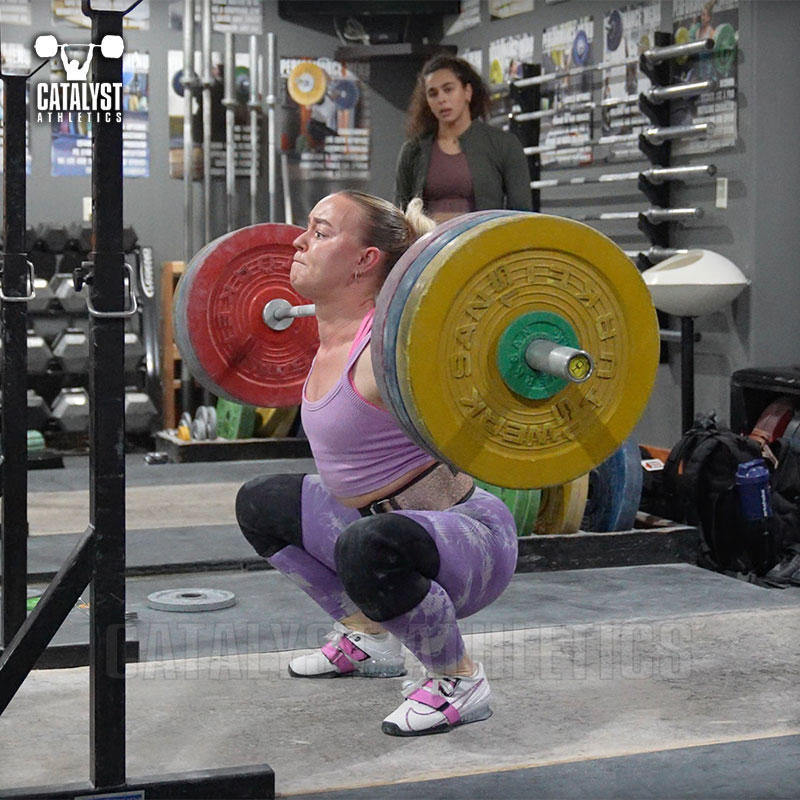Articles
Cardio for Olympic Weightlifting?
May 23 2024

May 23 2024

To get right to it: I don’t recommend dedicated Olympic weightlifters do actual cardio training for the sake of weightlifting. It will not make you a better weightlifter.
Based on the fact that I get questions about it twelve times a week, I recognize that a lot of you who do weightlifting even fairly seriously want to also build and maintain some kind of cardiovascular conditioning either for actual life activity, or just for a sense of general health and well-being. I’ll get to how to do this below.
First, understand that I’m talking about actual cardio/endurance training—running, riding, rowing, etc. at moderate efforts for extended periods of time. I’m not talking about a few minutes of very low intensity work in a warm-up or cooldown, or even for active recovery between sessions. Those things are brief and low intensity enough to have no meaningful effect beyond getting your body moving, warm and circulating blood, in the same way that doing one 60% deadlift isn’t going to have any effect on your strength.
To be clear, having a high level of cardiovascular conditioning itself doesn’t harm your weightlifting ability. The problem is the actual training interfering with your ability to develop your weightlifting-specific traits maximally. You’re asking your body to adapt in contradictory ways at a muscular level.
You’re also now adding more work for a body with finite amounts energy, time and resources for training and recovery, or to avoid adding more, you’re reducing your sport-specific training to accommodate the cardio. In either case, you’re limiting your potential progress in weightlifting.
But what about CrossFit?
Great question, I’m glad you asked.
First, yes: Elite CrossFitters show that a human being can have very highly developed traits across a broad spectrum, including great strength and endurance simultaneously.
However, these elite CrossFitters are a tiny fraction of the people who train this way. The CrossFit population on average doesn’t display anywhere near this level of ability.
This is true of elite weightlifters also. Even if you trained exactly the same way with the same coaching, the same nutrition, the same recovery, the same dedication as the best weightlifters in the world, you won’t necessarily replicate their abilities.
The reality is that elite athletes in any sport represent what is ultimately possible to achieve by the people naturally best suited for that activity who also dedicate themselves to it, not necessarily what you are able to achieve personally.
Moreover, despite the great abilities of the best crossfitters in the world, they still can’t match the weightlifting abilities of the best weightlifters in the world. So no matter how you look at it, crossfit is not evidence that cardio training is good for weightlifting, or even that it’s simply not detrimental.
How to Do it Anyway
Now, having totally broken your heart about what you’re capable of, and the myth that cardio training is going to somehow make you a better lifter, let me actually answer your question about how to do cardio training along with weightlifting if that’s what you want to do for other reasons.
The first part of this is to ensure that you’re simply not doing too much total training—that you’re doing a productive level of volume and frequency. This means finding a balance, likely reducing some of your current weightlifting training to allow for the addition of conditioning work.
The second part is the actual methodology. The biggest concern with doing conditioning work as a weightlifter is the contradictory stimulus for adaptation for the muscles, not the heart and lungs. In other words, asking your muscles on the one hand to be the best they can possibly be at lifting a very heavy weight, very explosively one time, but then also expecting them to be able to do a low level effort a million times in a row for an extended period of time.
The good news is that to exercise the actual cardiovascular system, we don’t really have to subject individual muscles to detrimental stimulus. And the way we get this conditioning work without causing that kind of stimulus is by not doing one motion or activity continuously for very long. We mix multiple movements using different muscles for brief periods of time, but continue to move constantly for a longer duration. In other words, we’re doing activity that demands work from the heart and lungs continuously, and even potentially very intensely, without considerable local muscular fatigue.
Generally, this means anything from 20 to 60 seconds per activity before alternating, and it means more variety is better. Going from a rower to a bike to a treadmill for 20 to 60 seconds each would be bare minimum type variety because it’s still all primarily leg work. Spreading the effort across the body more is better, and minimizing work by the legs, considering their primary role in weightlifting, is important.
A great thing to do is to add in any accessory work that doesn’t require a ton of focus on stability. For example, most of your ab work or bodybuilding type accessories can be mixed into a circuit with brief bouts of monostructural activity like bike, row or run. Really, most if not all of your accessory work can be done in a circuit with little to no rest, with or without the brief cardio work, to maintain elevated heart and breathing rates and get some cardiovascular benefit.
What about walking? 10,000 steps and all that? Will it kill your lifting gains? No… but it also won’t do much if anything for conditioning unless you’ve been sedentary for the last 8 years, or you’re walking at a blistering pace on challenging terrain, in which case you’re now introducing that contradictory stimulus we’re worried about.
So, in short, the trick is getting and keeping your heart and breathing rates up and forcing that system to work hard for an extended period of time without incurring significant local muscular fatigue or stress, and we do that by constantly changing the activity before we can develop any significant local fatigue.
Bodyweight & Cutting
Finally, some quick notes on using cardio for weight loss or cutting. In short, I don’t find it a good idea. First, if you’re looking for calorie reduction, you can achieve way more through nutrition than cardio, and do so without affecting the training stimulus in any way. If you’re looking at cardio for last-minute weight cuts for competition, that’s an even worse idea because you’re now draining energy and limiting restoration in the period you need it most.
The bottom line for me is that you should be using training for training, and nutrition for bodyweight and composition.
Based on the fact that I get questions about it twelve times a week, I recognize that a lot of you who do weightlifting even fairly seriously want to also build and maintain some kind of cardiovascular conditioning either for actual life activity, or just for a sense of general health and well-being. I’ll get to how to do this below.
First, understand that I’m talking about actual cardio/endurance training—running, riding, rowing, etc. at moderate efforts for extended periods of time. I’m not talking about a few minutes of very low intensity work in a warm-up or cooldown, or even for active recovery between sessions. Those things are brief and low intensity enough to have no meaningful effect beyond getting your body moving, warm and circulating blood, in the same way that doing one 60% deadlift isn’t going to have any effect on your strength.
To be clear, having a high level of cardiovascular conditioning itself doesn’t harm your weightlifting ability. The problem is the actual training interfering with your ability to develop your weightlifting-specific traits maximally. You’re asking your body to adapt in contradictory ways at a muscular level.
You’re also now adding more work for a body with finite amounts energy, time and resources for training and recovery, or to avoid adding more, you’re reducing your sport-specific training to accommodate the cardio. In either case, you’re limiting your potential progress in weightlifting.
But what about CrossFit?
Great question, I’m glad you asked.
First, yes: Elite CrossFitters show that a human being can have very highly developed traits across a broad spectrum, including great strength and endurance simultaneously.
However, these elite CrossFitters are a tiny fraction of the people who train this way. The CrossFit population on average doesn’t display anywhere near this level of ability.
This is true of elite weightlifters also. Even if you trained exactly the same way with the same coaching, the same nutrition, the same recovery, the same dedication as the best weightlifters in the world, you won’t necessarily replicate their abilities.
The reality is that elite athletes in any sport represent what is ultimately possible to achieve by the people naturally best suited for that activity who also dedicate themselves to it, not necessarily what you are able to achieve personally.
Moreover, despite the great abilities of the best crossfitters in the world, they still can’t match the weightlifting abilities of the best weightlifters in the world. So no matter how you look at it, crossfit is not evidence that cardio training is good for weightlifting, or even that it’s simply not detrimental.
How to Do it Anyway
Now, having totally broken your heart about what you’re capable of, and the myth that cardio training is going to somehow make you a better lifter, let me actually answer your question about how to do cardio training along with weightlifting if that’s what you want to do for other reasons.
The first part of this is to ensure that you’re simply not doing too much total training—that you’re doing a productive level of volume and frequency. This means finding a balance, likely reducing some of your current weightlifting training to allow for the addition of conditioning work.
The second part is the actual methodology. The biggest concern with doing conditioning work as a weightlifter is the contradictory stimulus for adaptation for the muscles, not the heart and lungs. In other words, asking your muscles on the one hand to be the best they can possibly be at lifting a very heavy weight, very explosively one time, but then also expecting them to be able to do a low level effort a million times in a row for an extended period of time.
The good news is that to exercise the actual cardiovascular system, we don’t really have to subject individual muscles to detrimental stimulus. And the way we get this conditioning work without causing that kind of stimulus is by not doing one motion or activity continuously for very long. We mix multiple movements using different muscles for brief periods of time, but continue to move constantly for a longer duration. In other words, we’re doing activity that demands work from the heart and lungs continuously, and even potentially very intensely, without considerable local muscular fatigue.
Generally, this means anything from 20 to 60 seconds per activity before alternating, and it means more variety is better. Going from a rower to a bike to a treadmill for 20 to 60 seconds each would be bare minimum type variety because it’s still all primarily leg work. Spreading the effort across the body more is better, and minimizing work by the legs, considering their primary role in weightlifting, is important.
A great thing to do is to add in any accessory work that doesn’t require a ton of focus on stability. For example, most of your ab work or bodybuilding type accessories can be mixed into a circuit with brief bouts of monostructural activity like bike, row or run. Really, most if not all of your accessory work can be done in a circuit with little to no rest, with or without the brief cardio work, to maintain elevated heart and breathing rates and get some cardiovascular benefit.
What about walking? 10,000 steps and all that? Will it kill your lifting gains? No… but it also won’t do much if anything for conditioning unless you’ve been sedentary for the last 8 years, or you’re walking at a blistering pace on challenging terrain, in which case you’re now introducing that contradictory stimulus we’re worried about.
So, in short, the trick is getting and keeping your heart and breathing rates up and forcing that system to work hard for an extended period of time without incurring significant local muscular fatigue or stress, and we do that by constantly changing the activity before we can develop any significant local fatigue.
Bodyweight & Cutting
Finally, some quick notes on using cardio for weight loss or cutting. In short, I don’t find it a good idea. First, if you’re looking for calorie reduction, you can achieve way more through nutrition than cardio, and do so without affecting the training stimulus in any way. If you’re looking at cardio for last-minute weight cuts for competition, that’s an even worse idea because you’re now draining energy and limiting restoration in the period you need it most.
The bottom line for me is that you should be using training for training, and nutrition for bodyweight and composition.








